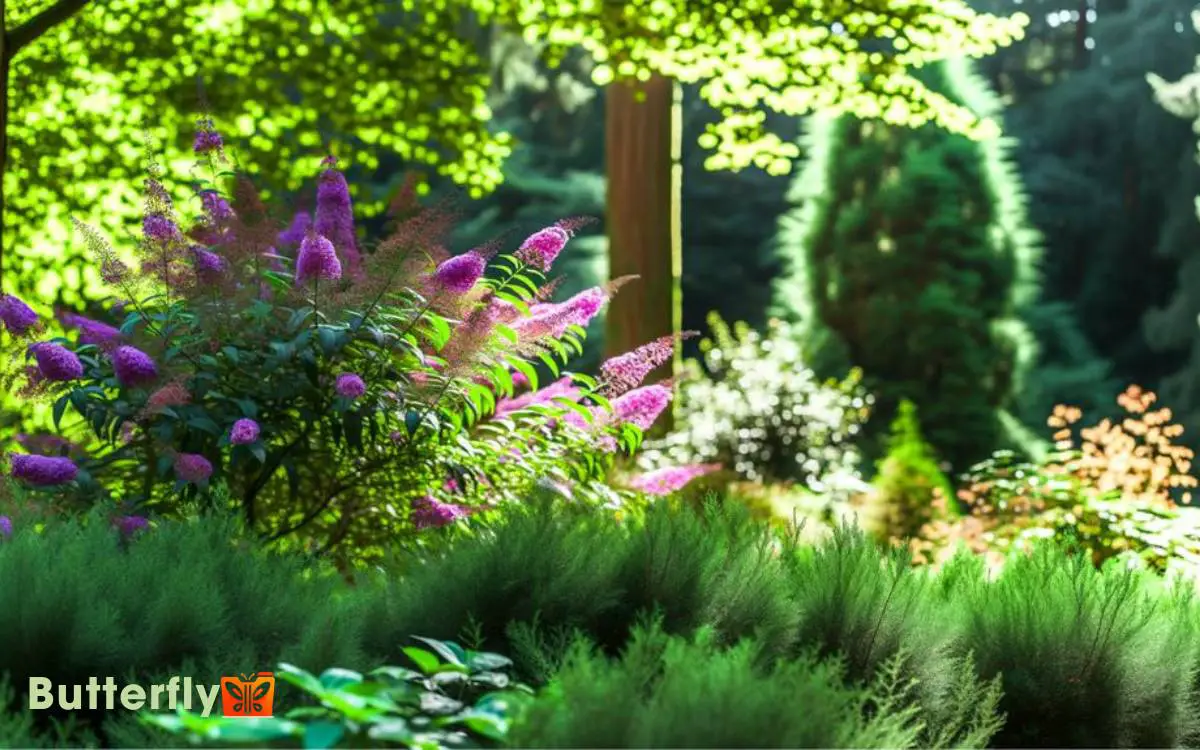Can Butterfly Bush Grow in Shade? Insights and tips!
Butterfly bushes thrive in full sun, needing at least six hours of direct sunlight daily for peak photosynthesis and vibrant blooms. They can tolerate partial shade with at least four hours of sunlight, though flowering will be less prolific and growth slows.
Regular pruning and proper watering enhance their health and pest resistance. To get the most out of your butterfly bush, exploring more details on their care can be quite beneficial.

Key Takeaways
Understanding Butterfly Bush Needs
To cultivate a healthy butterfly bush (Buddleja davidii), you need to understand its specific requirements for light, soil, and water. This perennial shrub thrives in well-drained soil with a slightly acidic to neutral pH (6.0-7.0).
You should avoid waterlogged conditions, as they can lead to root rot. Butterfly bushes prefer soil rich in organic matter, so incorporating compost can enhance growth.
When it comes to hydration, these plants require moderate watering, especially during the initial establishment phase. Once established, they exhibit drought tolerance but still benefit from regular watering during prolonged dry spells.
Understanding these foundational needs guarantees that your butterfly bush remains vigorous, promoting prolific blooming and robust health throughout the growing season.
Sunlight Requirements
You should know that Butterfly Bushes exhibit excellent growth under full sun conditions, receiving at least six to eight hours of direct sunlight daily.
However, research indicates they can tolerate partial shade, although you might observe reduced blooming.
In deep shade, these plants often struggle, showing stunted growth and diminished flower production.
Full Sun Preference
Butterfly bushes thrive best when they receive at least six hours of direct sunlight daily, a condition that maximizes their blooming potential and overall health. In full sun, these deciduous shrubs exhibit enhanced photosynthetic activity, leading to robust growth and prolific flowering.
Research indicates that adequate sunlight promotes higher chlorophyll production, which is essential for energy capture and utilization.
You’ll notice that butterfly bushes in full sun have more vibrant and numerous blossoms, attracting pollinators like butterflies and bees. Additionally, consistent sunlight exposure helps in minimizing the risk of fungal diseases.
Planting your butterfly bush in an area with unobstructed sunlight ensures it reaches its peak performance, demonstrating resilience and vigor in growth.
Partial Shade Tolerance
Although butterfly bushes prefer full sun, they can tolerate partial shade conditions with a minimum of four hours of direct sunlight daily to sustain healthy growth and moderate blooming.
You’ll notice that in partial shade, the plant’s growth rate may slow, and the flowering might be less prolific.
Here’s a quick comparison to help you understand the effects of light conditions:
| Light Condition | Growth Rate | Flowering Intensity |
|---|---|---|
| Full Sun | Best | Highest |
| Partial Shade | Adequate | Moderate |
| Less than 4 hours | Below optimal | Reduced |
Research shows that while butterfly bushes can adapt, they thrive best with more sunlight. Make sure they receive those essential four hours to maintain a healthy, vibrant garden.
Growth in Deep Shade
Growing in deep shade, butterfly bushes exhibit noticeably stunted growth and markedly reduced flowering due to insufficient sunlight. When deprived of adequate light, these plants can’t photosynthesize efficiently, leading to diminished vigor.
Studies indicate that butterfly bushes (Buddleja davidii) require at least six hours of direct sunlight to thrive. In deep shade, you’ll observe leggy stems with sparse foliage, a clear sign of light deprivation.
Flower production, a key attraction of these bushes, drastically decreases, impacting pollinator attraction. For best growth, situate your butterfly bush in a location with full sun or, at the very least, partial shade. Proper sunlight exposure ensures healthier blooms and encourages more frequent visits from butterflies and bees. Additionally, understanding butterfly bush propagation steps can help gardeners expand their collection and maintain vibrant growth. Regular pruning and well-drained soil further support the plant’s overall health and longevity.
Monitoring light levels and ensuring at least partial exposure is essential for maintaining the plant’s health and aesthetic appeal.
Growing in Partial Shade
When planting in partial shade, make certain the butterfly bush gets at least four to six hours of direct sunlight daily to promote peak blooming and growth.
Research indicates that insufficient sunlight can hinder photosynthesis, reducing flower production and vigor. Observations reveal that butterfly bushes in partial shade still exhibit robust growth, though flowering might be slightly less prolific compared to full sun conditions.
Confirm the soil is well-draining and moderately fertile, as these factors further support healthy development. Monitor for signs of etiolation, where stems elongate and leaves become sparse, indicating a need for more light.
With proper care, your butterfly bush can thrive and attract pollinators, even with limited sunlight.
Managing Full Shade
Cultivating butterfly bush in full shade challenges its growth and flowering potential due to greatly reduced light exposure, which impairs photosynthesis and overall plant health. To manage this, you’ll need to carefully take into account several factors meticulously.
First, make sure that the plant isn’t completely deprived of light. You might need to relocate it to an area with dappled sunlight or use reflective surfaces to boost light availability. Regularly monitor the plant’s health for signs of stress such as leggy growth or sparse blooming.
- Light augmentation: Use reflective materials or supplemental lighting.
- Prune strategically: Remove nearby foliage that blocks light.
- Monitor soil health: Ensure nutrients are adequate since poor light can’t be compensated by poor soil.
- Stress indicators: Watch for leggy growth, sparse blooms.
- Protection from pests: Reduced light can weaken the plant’s defenses.
Soil and Watering Tips
Ensuring essential soil health and consistent watering practices are important for the robust growth of your butterfly bush, particularly when light conditions are less than essential.
Start by ensuring well-drained soil with a pH ranging from 6.0 to 7.5. Incorporate organic matter such as compost to improve soil structure and nutrient content.
Water your butterfly bush deeply but infrequently, aiming for a thorough soaking once a week. This encourages deep root growth, which is critical in shaded environments.
Mulch around the base to retain moisture and regulate soil temperature. Avoid overwatering, as it can lead to root rot. Regularly monitor soil moisture levels to adjust your watering schedule based on rainfall and seasonal changes.
Enhancing Growth in Shade
Maximize your butterfly bush’s growth in shaded areas by selecting cultivars known for their shade tolerance and adjusting your care techniques accordingly. Research indicates that certain Buddleja species, like Buddleja alternifolia, exhibit better performance in lower light conditions.
Here are some steps to help you achieve this:
- Increase soil aeration: Loosen the soil to improve root oxygenation.
- Monitor moisture levels: Shaded areas may retain more moisture; adjust watering to avoid root rot.
- Apply balanced fertilizers: Use a formula with equal N-P-K ratios to promote even growth.
- Prune effectively: Remove dead or weak branches to enhance air circulation and light penetration.
- Mulch appropriately: Apply organic mulch to retain moisture and regulate soil temperature.
Common Challenges
While optimizing growth in shaded areas is possible, butterfly bushes often face common challenges such as insufficient flowering, pest infestations, and susceptibility to fungal diseases. Reduced sunlight limits photosynthesis, leading to fewer blooms and weaker plants.
Aphids, spider mites, and caterpillars frequently infest shaded butterfly bushes, feeding on foliage and causing further stress.
Moist, shaded environments also foster fungal pathogens like powdery mildew and root rot. Research suggests maintaining proper air circulation and avoiding overwatering to mitigate these issues.
Regularly inspect your plants for signs of pests or disease, and promptly use appropriate treatments. By addressing these challenges with informed strategies, you can improve the strength and resilience of your butterfly bushes, even in less-than-ideal light conditions.
Conclusion
To sum up, while butterfly bushes prefer full sun, they can tolerate partial shade if you provide them with well-draining soil and consistent watering.
However, growing them in full shade is like trying to fit a square peg in a round hole; their growth and blooming will be greatly hindered.
By understanding their sunlight needs and making necessary adjustments, you can still enjoy these vibrant plants even in less-than-ideal lighting conditions.






